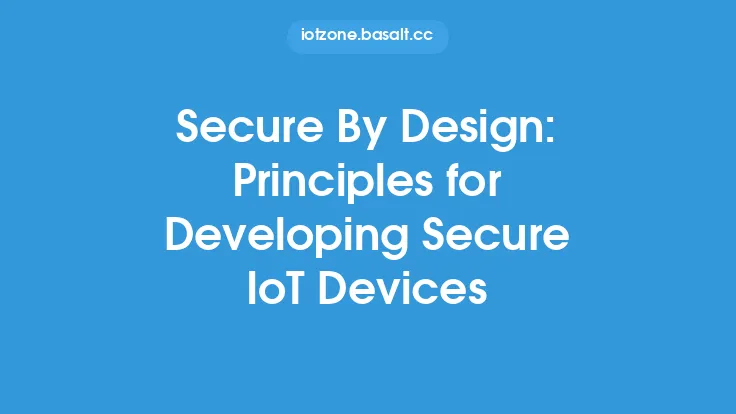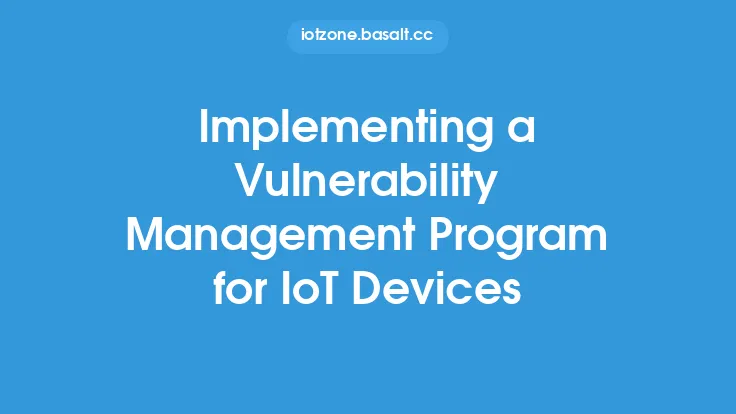The Internet of Things (IoT) has revolutionized the way we live and work, with an estimated billions of devices connected to the internet. However, this increased connectivity has also introduced new security risks, making it essential to implement a secure software development life cycle (SDLC) for IoT devices. A secure SDLC is a systematic approach to designing, developing, testing, and maintaining software that ensures the confidentiality, integrity, and availability of IoT devices and the data they process.
Introduction to Secure SDLC
A secure SDLC is a critical component of IoT device security, as it helps to identify and mitigate potential security risks throughout the entire development process. The SDLC consists of several phases, including requirements gathering, design, implementation, testing, deployment, and maintenance. Each phase must be carefully planned and executed to ensure that security is integrated into every aspect of the software development process. This includes conducting threat modeling, risk assessments, and security testing to identify and address potential vulnerabilities.
Security Requirements Gathering
The first phase of the SDLC is requirements gathering, where the functional and non-functional requirements of the IoT device are defined. During this phase, security requirements must be explicitly stated, including the types of data that will be collected, stored, and transmitted, as well as the security controls that will be implemented to protect that data. This includes defining the security protocols, encryption methods, and authentication mechanisms that will be used to secure the device and its communications. It is also essential to identify the potential security risks and threats associated with the device, including unauthorized access, data breaches, and denial-of-service attacks.
Secure Design Principles
The design phase of the SDLC is critical in ensuring the security of IoT devices. During this phase, the architecture and design of the device are defined, including the hardware, software, and firmware components. Secure design principles must be applied to ensure that the device is designed with security in mind. This includes implementing secure communication protocols, such as Transport Layer Security (TLS) or Datagram Transport Layer Security (DTLS), to protect data in transit. Additionally, secure coding practices must be followed, including input validation, error handling, and secure data storage.
Implementation and Coding
The implementation phase of the SDLC is where the design is translated into code. During this phase, secure coding practices must be followed to ensure that the code is free from vulnerabilities and bugs. This includes using secure coding languages, such as C or Rust, and following secure coding guidelines, such as the OWASP Secure Coding Practices. Additionally, code reviews and pair programming must be conducted to ensure that the code is thoroughly tested and validated.
Security Testing and Validation
Security testing and validation are critical components of the SDLC, as they help to identify and address potential security vulnerabilities. During this phase, various types of security testing must be conducted, including penetration testing, vulnerability scanning, and fuzz testing. These tests help to identify potential security weaknesses, such as buffer overflows, SQL injection, and cross-site scripting (XSS). Additionally, security validation must be conducted to ensure that the device meets the security requirements defined during the requirements gathering phase.
Deployment and Maintenance
The final phase of the SDLC is deployment and maintenance, where the IoT device is deployed and maintained in production. During this phase, security patches and updates must be regularly applied to ensure that the device remains secure. Additionally, security monitoring and incident response plans must be implemented to quickly respond to security incidents. This includes implementing intrusion detection and prevention systems, as well as incident response plans to quickly contain and mitigate security breaches.
Secure Coding Practices
Secure coding practices are essential in ensuring the security of IoT devices. This includes following secure coding guidelines, such as the OWASP Secure Coding Practices, and using secure coding languages, such as C or Rust. Additionally, code reviews and pair programming must be conducted to ensure that the code is thoroughly tested and validated. Secure coding practices also include implementing secure communication protocols, such as TLS or DTLS, to protect data in transit.
Threat Modeling and Risk Assessments
Threat modeling and risk assessments are critical components of the SDLC, as they help to identify and mitigate potential security risks. During the threat modeling phase, potential security threats are identified, including unauthorized access, data breaches, and denial-of-service attacks. Risk assessments are then conducted to determine the likelihood and impact of these threats, and to identify the security controls that must be implemented to mitigate them.
Compliance and Regulatory Requirements
IoT devices must comply with various regulatory requirements, including the General Data Protection Regulation (GDPR) and the Health Insurance Portability and Accountability Act (HIPAA). During the SDLC, these regulatory requirements must be carefully considered, and the device must be designed and implemented to meet these requirements. This includes implementing security controls, such as encryption and access controls, to protect sensitive data.
Conclusion
Implementing a secure software development life cycle is critical in ensuring the security of IoT devices. By following a systematic approach to designing, developing, testing, and maintaining software, IoT device manufacturers can help to identify and mitigate potential security risks. This includes conducting threat modeling, risk assessments, and security testing, as well as implementing secure coding practices and secure design principles. By prioritizing security throughout the entire development process, IoT device manufacturers can help to ensure the confidentiality, integrity, and availability of IoT devices and the data they process.





